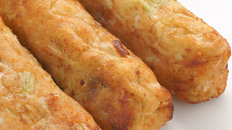Meats and Sausages
Glamorgan
Glamorgan sausage, a traditional Welsh vegetarian sausage, made of cheese, leeks and bread crumbs. The sausage is not stuffed into casings, but rather rolled in a cylindrical shape, dipped in egg and coated with bread crumbs. The sausage earned its name from Glamorgan cheese once made in Wales from the milk of a breed of cattle also named Glamorgan. There are few Glamorgan cattle remaining to produce milk for making Glamorgan cheese on a larger scale. However, Caerphilly is very similar and is used for making Glamorgan sausage.
| Materials | Metric | US |
|---|---|---|
| Bread crumbs | 350 g | 0.77 oz |
| Caerphilly cheese, grated | 200 g | 0.44 oz |
| Leeks, chopped | 250 g | 0.55 oz |
| Eggs | 150 g | 0.33 oz (2 eggs) |
| Milk | 60 ml | 2 oz fl |
Ingredients per 1000g (1 kg) of materials
| Salt | 12 g | 2 tsp |
| Pepper | 2.0 g | 1 tsp |
| Fresh parsley, chopped | 1 Tbsp | |
| Thyme or rosemary, dried | 1 tsp | |
| Mustard, ground | 1.0 g | 1/2 tsp |
| Oil for frying | as needed |
Instructions
- Place the breadcrumbs, cheese, seasoning, mustard, leek and parsley into a mixing bowl, mix well. Beat the eggs and add to the mixture. Add enough milk for the mixture to bind. Divide the mixture into equal parts. Using hands form each portion into a sausage shape.
- Coating mix: beat another egg and add the milk. Spread the breadcrumbs (or flour) on a plate. Roll each sausage in the egg mixture, then roll in the bread crumbs.
- Fry the sausages in oil or melted butter for 5-10 minutes until they become gold-brown. Some people prefer to grill them till golden or bake them in an oven for about 15-20 minutes.
Notes
It might be hard finding Caerphilly cheese outside the UK. It is a hard, white, sharp, crumbly cheese with slightly sour tang. You can substitute a mild cheddar-style cheese or feta.


















